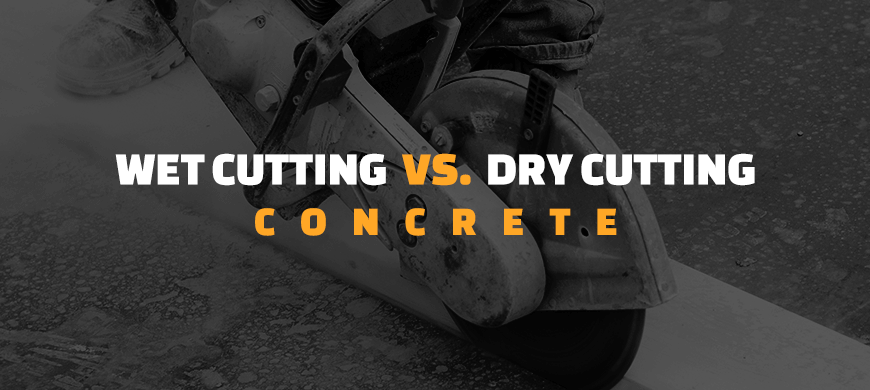
Wet Cutting vs. Dry Cutting Concrete
Posted By:Dynamic Concrete Pumping , Date: Sep 17, 2020

Although there are many concrete sawing techniques, one of the most effective and popular is diamond cutting. Diamond saws are known for their cleaner cuts because they are less likely to fracture the concrete’s surface. They have synthetic diamonds embedded into the saw blade, and as the crystals fracture, they create more cutting surfaces. So, the saw becomes more effective with use. Diamond blades produce a high-quality cut, resist wear and last longer.
While both sawing methods use a diamond blade, there are a few critical differences when it comes to dry cutting vs. wet cutting concrete. It’s crucial to understand how both sawing techniques work and select the right one for your application.
Dry Cutting Concrete
Dry cutting uses a specialized diamond blade that can withstand more heat. It’s most often used with a hand-held saw with low horsepower for small-scale construction. Without water for cooling, the saw uses the surrounding air to cool down the blade, which is why it must free spin between cuts to increase the airflow. You can pair a dry-cutting saw with a dust extractor or vacuum to catch concrete dust in a bag.
A hand-held dry-cutting saw should only be used to make cuts 1.5 inches deep per pass and must cool down between cuts. For more heavy-duty, industrial, commercial and paving applications, concrete cutters turn to the Husqvarna Soff-Cut® 4200. This 23 horsepower saw can cut a maximum depth of 3 inches per pass. It can take multiple blade widths, allowing for varying control joint widths and simultaneous crack control.
Husqvarna Soff-Cut saws and diamond blades increase uptime, improve precision and get the job done quickly and efficiently. The Soff-Cut brand is synonymous with the dry-cutting technique. Soff cutting is what industrial construction projects use for high-performance dry-cutting applications.
Advantages of Dry Cutting
There are many benefits of dry cutting concrete, including:
- Simplified cutting: Dry cutting creates shallow, straight cuts. It makes these simple jobs even more straightforward.
- No plug required: The Husqvarna 4200 is self-propelled with a twin-cylinder gasoline engine. The machine can be used anywhere dry cutting is required, even a remote parking lot.
- No water required: While wet cutting requires a constant stream of pressurized water, dry cutting uses airflow to prevent overheating. Use dry cutting when there is no water source or when the job site needs to stay dry at all times, such as indoor construction.
- Cleaner job site: During wet cutting, water combines with dust, creating a concrete slurry. While this minimizes dry particles in the air, it creates a mess to clean. Dry cutting creates a cleaner job site and can be combined with a dust extractor or vacuum to remove dust. According to a study by the Centers for Disease Control and Prevention (CDC), a shroud and vacuum cleaner can reduce quartz and respirable dust exposure by 95%. In comparison, wet cutting reduces quartz exposures by 90% and respirable dust exposure by 88%.
- Safe around other equipment: Without water sprayed on the cutting surface, there is no chance of splashing. Dry cutting is less intrusive, meaning contractors can carry on with construction work, even with electrically-powered equipment, while the saw is in use.
- Sharp detailing: A dry-cutting saw is known for detailing and finishing work and can create a flatter, smoother surface. It can score or create decorative patterns.
- Longer-lasting blade: While all diamond blades are long-lasting, those designed for dry cutting are more durable and heat-resistant. Since they have no water source to provide cooling, these blades stay sharp for decreased maintenance.
Disadvantages of Dry Cutting
Dry cutting doesn’t work for every application. There are a few drawbacks to using the method, such as:
- Respiratory dust: Without water, the dust released during sawing poses a health risk. Engineering controls, such as a dust vacuum, can reduce respiratory hazards. Follow Occupational Safety and Health Administration (OSHA) guidelines to mitigate health risks. You can refer to Table 1 in 29 CFR 1926.1153 to determine if your equipment requires an APF 10 respirator.
- No curved cuts: Dry cutting can only create straight lines.
- Intermittent use: Dry cutting can take longer and requires more downtime. Industrial soff-cutting equipment can minimize this downtime.
Wet Cutting Concrete
Wet cutting also uses a diamond blade, which is cooled by water as it saws the concrete. The water sprays directly onto the cutting surface. Wet cutting can reduce respiratory health risks by turning the concrete dust into sludge. Wet cutting typically uses a walk-behind saw and is often used in large-scale construction to cut through flat concrete. It requires a continuous stream of water to prevent the blade from warping or losing segments.
Wet-cutting saws operate at high revolutions per minute (RPM), which means they can cut longer. Because they use water, most wet-cutting tools run on either diesel or gasoline to prevent electrocution hazards. They might come with a water reservoir or a hose attachment to distribute water during use.
Advantages of Wet Cutting
There are several benefits of wet cutting concrete, including:
- Health and safety: Because a constant stream of water turns airborne dust into a slurry, it reduces the risk of respiratory dust exposure. The water cools down the tool more effectively, so there is also a smaller risk of overheating-related hazards.
- Protection for blades: Keeping the surface wet during operation puts less stress on the saw. While these blades don’t have a heat-resistant construction like dry-cutting blades, the water can preserve the segments.
- More precise cuts: Wet cutting reduces downtime and can be used for more extended periods of continuous use. Without frequent stops, wet cutting can achieve a cleaner cut.
- Less risk of overheating: With water cooling, the machine has a smaller chance of overheating. Less heat reduces maintenance and increases uptime.
Disadvantages of Wet Cutting
Wet cutting can pose some significant cons, such as:
- Messier job site: As water sprays over the cutting surface, it can splash nearby surfaces that must be kept dry. The method also turns dust into a concrete sludge, which must be cleaned up, contained and disposed of safely.
- Potential for damage or chipping: Since wet cutting is more abrasive, it can damage some materials, such as porcelain. It can chip tiles, so you must use an adjustable blade for tile work.
- Constant water supply: Wet cutting requires a continuous water supply. In some construction sites, it may be challenging to find a reliable water source. You must also use other equipment to pressurize the water because the attached water pump is not designed as a primary pressure source.
- Shorter lifespan: Wet-cutting machines generally have a shorter lifespan than dry-cutting saws.
- Electrical hazards: The splashing water can create hazards with any surrounding electrically-powered equipment. Remove any nearby machinery which is not water-safe before wet cutting.
Which Cutting Method Should You Use?
Choosing to use wet cutting or dry cutting can depend on the application. Still, both are effective for various jobs. Dry cutting is typically best for indoor use, especially when the area must stay dry at all times. It’s also suitable for job sites with limited access to water. While the stream of water used for wet cutting produces less dust, it makes the task messier. However, wet cutting can be used for thicker materials and jobs that require constant rather than intermittent cutting.
Contractors mainly use wet cutting for tile work, reinforced concrete, metal, bricks and masonry. It can produce long, clean cuts because it is less prone to overheating or wearing the blade. If electrocution is a potential hazard, consider dry cutting instead.
Dry cutting is better for short, intermittent cutting, which makes it excellent for shaping, detailing and finishing work. You can create deeper cuts using dry cutting so long as you use proper precautions, allowing the blade to free-spin and cool down periodically while cutting.
Whichever method you choose, you should also understand when to cut concrete. Cutting too early can cause the blade to pull the cement out of position, leaving a weakened, uneven edge. Cutting too late can increase cracking when the concrete contracts. In hot weather, you can cut around four hours after the pour. In colder conditions, you may have to wait up to 12 hours.
Dynamic Concrete: Your Partner for Dry Cutting Concrete
If you decide dry cutting outweighs wet cutting and need a professional, heavy-duty cut, trust Dynamic Concrete. Our Soff Cutting Division is highly-trained in the latest concrete cutting methods and equipment and takes a custom approach to every job. As concrete specialists for over 40 years, we are committed to our clients and provide 100% satisfaction on every project. Learn more about our Soff Cutting services today.

